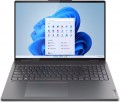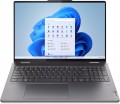Model
The specific model of the processor installed in the laptop, or rather, the processor index within its series (see above). Knowing the full name of the processor (series and model), you can find detailed information on it (up to practical reviews) and clarify its capabilities.
Code name
The code name for CPU installed in the laptop.
This parameter characterizes, first of all, the generation to which the processor belongs, and the microarchitecture used in it. At the same time, chips with different code names can belong to the same microarchitecture/generation; in such cases, they differ in other parameters - general positioning, belonging to certain series (see above), the presence / absence of certain specific functions, etc.
Nowadays, the following code names are relevant in Intel processors:
Coffee Lake,
Comet Lake,
Ice Lake,
Tiger Lake,
Jasper Lake,
Alder Lake,
Raptor Lake (13th Gen),
Alder Lake-N,
Raptor Lake (14th Gen),
Meteor Lake (Series 1),
Raptor Lake (Series 1),
Lunar Lake (Series 2).
For AMD, the list looks like this:
Zen 2 Renoir,
Zen 2 Lucienne,
Zen 3 Cezanne,
Zen 3 Barcelo,
Zen 3+ Rembrandt,
Zen 3+ Rembrandt R,
Zen 2 Mendocino,
Zen 3 Barcelo R,
Zen 4 Dragon Range,
Zen 4 Phoenix
Zen 4 Hawk Point,
Zen 5 Strix Point,
Zen 5 Strix Halo.
Detailed data on different code names can be found in special sources.
CPU speed
The clock speed of the processor installed in the laptop (for multi-core processors, the frequency of each individual core).
Theoretically, a higher clock speed has a positive effect on performance, as it allows the processor to perform more operations per unit of time. However, in fact, the capabilities of the CPU depend on a number of other characteristics — primarily on the series to which it belongs (see above). It even happens that of the two chips, the more performant in the overall result is the slower one. With this in mind, it makes sense to compare by clock frequency only processors of the same series, and ideally, also of the same generation; and the laptop as a whole should be judged by the complex characteristics of the system, as well as by the results of tests (see below).
TurboBoost / TurboCore frequency
Processor clock speed achieved in TurboBoost or TurboCore "overclocking" mode.
Turbo Boost and Turbo Core technologies are used by different manufacturers (Intel and AMD, respectively), but they have the same principle of operation: load distribution from more loaded processor cores to less loaded ones to improve performance. The "overclocking" mode is characterized by an increased clock frequency, and it is indicated in this case.
For more information about clock speed in general, see the relevant paragraph above.
3DMark06
The result shown by the laptop processor in 3DMark06.
This test is primarily focused on testing performance in games — in particular, the ability of the processor to process advanced graphics and artificial intelligence elements. Test scores are reported as scores; the higher this number, the higher the performance of the tested chip. Good 3DMark06 results are especially important for
gaming laptops.
Passmark CPU Mark
The result shown by the laptop processor in the Passmark CPU Mark test.
Passmark CPU Mark is a comprehensive test that is more detailed and reliable than the popular 3DMark06 (see above). It checks not only the gaming capabilities of the CPU, but also its performance in other modes, based on which it displays the overall score; this score can be used to fairly reliably evaluate the processor as a whole (the more points, the higher the performance).
SuperPI 1M
The result shown by the laptop processor in the SuperPI 1M test.
The essence of this test is to calculate the number "pi" to the millionth decimal place. The time spent on this calculation is the final result. Accordingly, the more powerful the processor, the smaller the result will be (this SuperPI 1M is fundamentally different from many other tests).
RAM speed
The clock speed of the RAM installed in the laptop.
The higher the frequency (with the same type and amount of memory) — the higher the performance of RAM in general and the faster the laptop will cope with resource-intensive tasks. However modules with the same frequency may differ somewhat in actual performance due to differences in other characteristics; but this difference becomes significant only in very specific cases, for the average user it is not critical. As for specific values, the most popular modules on the modern market are
2400 MHz,
2666 MHz,
2933 MHz and
3200 MHz. Memory at
2133 MHz or less is found mainly in outdated and low-cost devices, and in high-performance configurations this parameter is
2933 MHz,
3200 MHz,
4266 MHz,
4800 MHz,
5200 MHz,
5500 MHz,
5600 MHz,
6000 MHz,
6400 MHz and
more.
Connection ports
Connection connectors provided in the design of the laptop.
This paragraph mainly indicates data on video outputs:
VGA,
HDMI(versions 1.4,
2.0,
2.1 and their varieties),
miniHDMI /
microHDMI,
DisplayPort,
miniDisplayPort). In addition, the presence of other types of connectors can be specified here: audio
S / P-DIF, service
COM port. But information about interfaces such as full-sized USB, USB-C, Thunderbolt and LAN is provided in separate paragraphs (see below).
— VGA. Analogue video output, also known as D-Sub 15 pin. Technically considered obsolete: it has low noise immunity, does not provide sound transmission, and the maximum supported resolution in fact does not exceed 1280x1024. However, VGA inputs are still quite common in monitors today, and are also found in other types of video equipment — in particular, projectors. Therefore, some modern laptops, mainly for multimedia purposes, are equipped with similar outputs — counting on connection to the mentioned video devices.
— HDMI. The most popular modern interface for working with HD content. Uses digital data transmission, allows you to transmit high-def
...inition video and multi-channel audio over one cable at the same time. Most modern monitors, TVs, projectors, and other HD-enabled video equipment have at least one HDMI input; so outputs of this type are extremely common in modern laptops.
— microHDMI and miniHDMI. Reduced varieties of the HDMI described above: they are completely similar in functionality and differ only in the size of the connector. They are installed mainly in the thinnest and most compact laptops, for which full-size HDMI is too cumbersome.
The HDMI and mini/microHDMI ports on modern laptops may correspond to different versions:
- v 1.4. The earliest of the commonly used standards, released in 2009. Allows you to transmit a signal in resolutions up to 4096x2160 at a frame rate of 24 fps, and with Full HD resolution, the frame rate can reach 120 fps; 3D video transmission is also possible.
- v 1.4a. The first addition to version 1.4, in which, in particular, two additional 3D video formats were added.
- v 1.4b. The second update of the HDMI 1.4 standard, which introduced only minor clarifications and additions to the v 1.4a specifications.
- v2.0. Global HDMI update introduced in 2013. Also known as HDMI UHD, it allows you to stream 4K video at frame rates up to 60 fps. The number of audio channels can reach 32, and up to 4 audio streams can be broadcast simultaneously. In addition, support for the 21:9 aspect ratio and some improvements regarding 3D content have been introduced.
- v2.0a. First HDMI 2.0 update. A key innovation was compatibility with HDR content (see "HDR support").
- v2.0b. Second update of version 2.0. Key innovations have affected mainly work with HDR — in particular, support for HDR10 and HLG has been added.
- v2.1. One of the newest versions, released in the fall of 2017. Further increases in bandwidth have made it possible to support 4K and even 8K video at frame rates up to 120 fps. In addition, key improvements include enhanced HDR capabilities. Note that to use the full capabilities of HDMI v2.1, HDMI Ultra High Speed cables are required, although basic functions are available with regular cables.
— Display port. Digital high-speed port, allows you to transfer both video and audio in HD quality. It is similar in many respects to HDMI, provides a higher data transfer rate and allows the use of longer cables, but is less common, mainly used in computer technology.
— miniDisplayPort. A smaller version of the DisplayPort described above, designed to make the connector more compact; except for the dimensions, it is no different from the original interface. Some time ago it was a regular video connector for Apple laptops; and even the Thunderbolt interface that replaced it, in versions 1 and 2 (see below), uses a connector identical to the miniDisplayPort connector.
Both full-size DisplayPort and its smaller version may be different versions. Here are the most popular options today:
- v 1.2. The earliest version common in laptops, released in 2010. Among the most important innovations presented in this version are 3D support, the ability to work simultaneously with several video streams for serial connection of screens (daisy chain), as well as the ability to work through the miniDisplayPort connector. Bandwidth v 1.2 is enough to fully support 5K video at 30 frames per second and 8K video — with certain limitations.
- v 1.2a. Update version 1.2, released in 2013. One of the most noticeable innovations is the ability to work with AMD FreeSync (see above). Bandwidth and supported resolutions remain unchanged.
- v 1.3. DisplayPort version released in 2014. Compared to the previous version, the throughput has been increased by 1.5 times for 1 line and almost 2 times for the whole connector (8.1 Gbps and 32.4 Gbps, respectively). This, among other things, made it possible to provide full support for 8K video at 30 fps, as well as increase the maximum frame rate in 4K and 5K standards to 120 and 60 fps, respectively. In daisy chain mode, this standard makes it possible to work with two 4K UHD (3840x2160) screens at a frame rate of 60 Hz, or with four 2560x1600 screens at the same frequency. In addition, Dual-mode support was introduced in this version, providing compatibility with HDMI and DVI interfaces through the simplest passive adapters.
- v 1.4. Version introduced in March 2016. Bandwidth, compared to the previous standard, remained unchanged, but some important features were added — in particular, support for Display Stream Compression 1.2 compression, HDR10 standard and Rec. 2020, and the maximum number of supported audio channels has increased to 32.
- v 1.4a. An update released in 2018 "quietly" — without even an official press release. The main innovation was the update of Display Stream Compression technology from version 1.2 to version 1.2a.
— S/P-DIF. Output for digital audio transmission, including multi-channel. It has two varieties — optical and electrical; the first is absolutely insensitive to interference, but uses rather delicate cables, the second does not require special care in handling, but can be subject to pickups (although the wires are usually made shielded). Laptops use mainly optical S/P-DIF, while for compactness this connector is combined with a mini-Jack jack for connecting headphones. However, anyway, it's ok to clarify the specific features of this interface separately.
— COM port. Universal interface for connecting various external devices — in particular, dial-up modems — as well as for direct connection between two computers. Also known as RS-232 (after the connector). Nowadays it is considered obsolete due to the spread of more compact, faster and more functional interfaces, primarily USB. However, many types of equipment, including specialized ones, use the COM port as a control interface. Such equipment includes uninterruptibles, satellite receivers and communication devices, security and alarm systems, etc. Thus, COM ports, although almost never used in consumer-level laptops, are still found in some specialized models.
